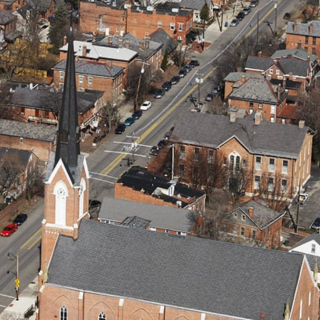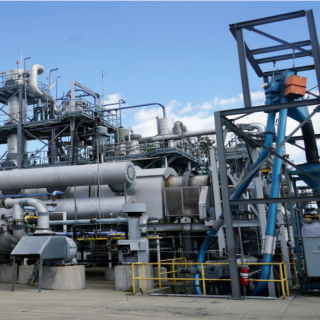The future of energy generation in Ohio hangs in the balance with House Bill 6(HB6) and May 22 and 23 saw some pivotal events in the saga of this bill. Protests and hearings laid out two very different paths Ohio could go down, one filled with nuclear contamination and countless tons of waste, the other with clean energy from wind and solar. The proposed law would add a charge to every Ohioan's electric bill in order to bail out the Davis-Besse and Perry nuclear plants. These crumbling, leaking plants can no longer compete in terms of price with wind, solar, or gas generation. Initially, the bill tried to pass itself off as a pro-environmental bill. The official title states that it was intended "to create the Ohio Clean Air Program, to facilitate and encourage electricity production and use from clean air resources..." and never actually mentioned nuclear power. However, it quickly became clear that restrictions on how generation sources could access money from the charges meant that most of the money would go to First Energy to bail out their failing nuclear plants. Wind farms and solar fields would not be eligible. In the latest versions of the bill, money is also specifically earmarked for coal and natural gas plants. So, Ohio's "Clean Air" bill would fund nuclear, coal, and natural gas, but not wind or solar.
Many hearings have been held on HB6, starting on April 23 in front of the Energy Generation subcommittee of the House Energy and Natural Resources Committee and later in front of the full Committee. Most of the testimony, from a wide variety of business and environmental organizations, has been in opposition. The bulk of the criticism centered around that fact that the bill eliminates Ohio's energy efficiency and Alternative Energy Portfolio Standards(AEPS) programs. The efficiency program, which grants interest free loans to do things like insulating buildings or buying energy efficient manufacturing equipment, has resulted in over $5 billion in savings for Ohio businesses, while only costing about $1 billion. The AEPS program has created a boom in solar installations in Ohio. Together, the programs have generated about 100,000 jobs and avoided millions of tons of carbon emissions. Most of the support for HB6 has come from First Energy itself, or corporations that supply the nuclear plants, or with the labor organizations that are employed there.
However, there are a few organizations that oppose the bill precisely because it does support nuclear. These are the groups that came together with just a few hours' notice to stage a protest in front of the Ohio Statehouse at 8AM on Wednesday morning. They had received word that the labor unions who represented the workers at the nuke plants were going to hold a pro-HB6 rally, but that apparently never materialized. More than a dozen people from the Ohio Green Party, Ohio Citizen Action, and the Sierra Club held signs and chanted "No Nukes!" Harvey Wasserman, the creator of the phrase "No Nukes!" was also in attendance.
At 9AM, many of the protestors went in to the hearings in front of the full Energy Committee. There, a string of witnesses gave testimony that was in turn impassioned, humorous, or deadly serious. Witnesses were again overwhelmingly opposed to the bill. Three spoke in favor, while nine spoke in opposition. Most of the support again came from labor as representatives emotionally described the harm to their members that would come as a result of closing the plant. One highlight came as Representative Leland questioned Matt Szollosi from ACT. Rep. Leland asked "What if we gave all your members $100,000 for ten years instead of passing this bill? We'd take care of your members and save the rate payers of Ohio a lot of money."
The opposition was equally impassioned. Pat Marida described the contamination at schools in Piketon, and connected that contamination to the nuclear industry, since much of it came from waste reprocessing. She reports that clean up at Piketon is estimated at $18 billion. Ned Ford argued against subsidizing any electric generator, and in favor of continuing the current efficiency and alternative energy programs, saying "If it is working, don't fix it."
Harvey Wasserman gave the most impassioned testimony, challenging the Committee, "Do we live in a Socialist state or a Capitalist state?" He called the bailout Socialism, since the government would directly fund First Energy through charges to consumers. He also stressed that "Davis-Besse WILL close..." regardless of whether HB6 passes or not, since the leaking, crumbling plant is already well past its engineered lifspan. He called the plants "obsolete" and said that the fact that the plants need a bailout and can't compete in the marketplace proves they are obsolete. In the questioning afterwards, Rep Vitale asserted that Harvey has no authority to criticize Davis-Besse, "Since he's never even been inside the plant." Vitale spoke in glowing terms of Davis-Besse's shiny and clean plumbing and complimented the pictures hanging on the wall of the NRC resident inspectors.
Glenn Thomas from PJM, the non-profit that runs the regional electric grid, spoke in opposition to HB6, saying that by eliminating competition the bill ensures higher prices and less dependable electrical supply. Rachel Belz, from Ohio Citizen Action spoke in opposition to the bailout, but added in questioning that she "believes in opportunites for all energy sources." John Perry retold the story of Davis-Besse's near catastrophic "hole-in-the-head" accident, where boric acid came within 3/8 of an inch of eating all the way through the reactor head and causing an ustoppable meltdown. Akshai Sing oppoed the bailout on economic grounds and opposed the bill's creation of a "clean air board" which would steer the money to the nuke plants.
Joseph DeMare was the final speaker. He focused on the dangers of radioactive waste, talking about the more than 200 radioactive isotopes created every moment that nuclear plants operate and describing how radiation tears cells apart, causing cancers and other diseases. He also asserted that any nuclear plant that relies on constant water circulation to prevent meltdown and explosion is obsolete in the wake of the Fukushima disaster. On questioning, Rep. Stein showed a graph which alleged that there have never been any deaths from the nuclear power industry. Joe responded by citing studies showing leukemia and thyroid cancer doubling near nuke plants and pointing out that is one reason Germany is completely abandoning nuclear power. He also said that, since radioactive waste will continue to cause death and disease for hundreds of thousands of years, if he and Stein were to look at the graph again in 200,000 years the bar showing death from nukes would "extend beyond the ceiling."
The next day, testimony continued, again mostly in opposition, until about 2 PM when Rep Stein moved that the Committee approve the bill. Rep. Leland objected, pointing out that the Democrats had amendments to offer and wanting more information about a new provision, inserted about an hour before, that included an Indiana coal plant in the bailout. So Ohioans would be charged money that would then be sent to Indiana. Co-Chair Vitale ignored Leland's protest and the bill passed along Party lines 7-3. It now goes before the entire Legislature.
Speaker Householder has vowed it will be voted on in a few days. He previously recieved a $70,000 donation from the Republican Party of Ohio, $38,000 of which came from former First Energy CEO Anthony Alexander. Householder had to return the money, because it violated campaign finance law. Despite the obvious appearance that the donation was made in order to secure this bailout, and despite the fact that First Energy itself has made about $150,000 in donations to the Republicans who will be voting on this bill, Householder and the other Republicans deny that they have been bought and paid for.



